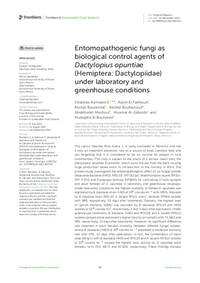Entomopathogenic fungi as biological control agents of Dactylopius opuntiae (Hemiptera: Dactylopiidae) under laboratory and greenhouse conditions

Authors:
The cactus Opuntia ficus-indica L. is widly cultivated in Morocco and has a very an important economic role as a source of food, livestock feed and not forgetting that it is considered to be an income for people in rural communities. This crop is subject to the attack of a serious insect pest, the Dactylopius opuntiae (Cockerell), which sucks the sap from the plant causing huge production losses since its introduction to the country in 2014. The present study investigated the entomopathogenic effect of six fungal isolates {Beauveria bassiana [HASS; RFSL10; SPT 011(a)]; Akanthomyces lecanii [RFSLV; SPT R 215] and Cordyceps farinosa [SPSBI4]} for controlling of both nymphs and adult females of D. opuntiae in laboratory and greenhouse bioassays. Under laboratory conditions, the highest mortality of female D. opuntiae was registered by B. bassiana strain HASS at 108 conidia ml−1 with 100%, followed by B. bassiana strain RFSL10, A. lecanii RFSLV, and C. farinosa SPSBI4 isolates with 98%, respectively, 10 days after treatments. Similarly, the highest level of nymph mortality (100%) was recorded by B. bassiana RFSL10 and HASS isolates at 108 conidia ml1, respectively, 4 and 5 days after application. Under greenhouse conditions, B. bassiana (HASS and RFSL10) and A. lecanii (RFSLV) isolates sprayed alone expressed a higher toxicity on nymphs with 75, 68.5 and 58%, respectively, 12 days after treatments. However, no significant difference was observed in adult female's mortality between different fungal isolates, where B. bassiana (HASS) at 108 conidia ml−1 presented a moderate mortality rate with 55%, 12 days after application. In fact, the combination of black soap (60 g/L) with B. bassiana HASS and RFSL10 and A. lecanii (RFSLV) isolates at 108 conidia ml−1 caused the highest toxic activity on D. opuntiae adult females, with 70.5, 68.75 and 67.65%, respectively. These findings showed that entomopathogenic fungi are promising for developing a biopesticide formulation for the management of D. opuntiae as an adequate and safe alternative to chemical pesticides.
